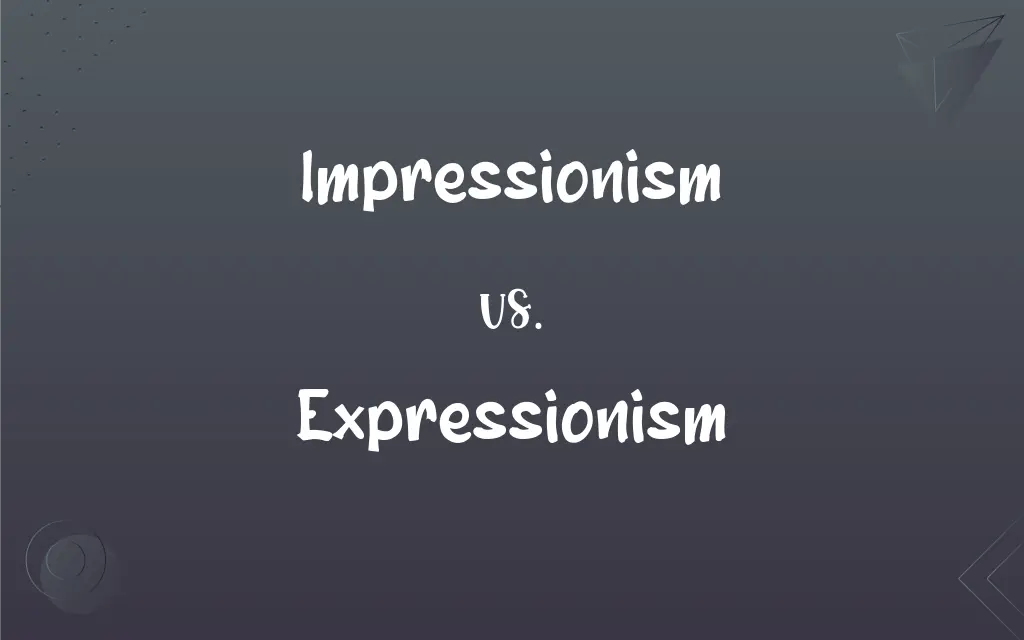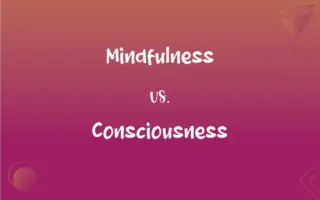Impressionism vs. Expressionism: What's the Difference?
Edited by Aimie Carlson || By Janet White || Published on December 1, 2023
Impressionism captures fleeting effects of light and color in nature, while Expressionism conveys emotion and meaning through exaggerated, distorted forms.

Key Differences
Impressionism, a 19th-century art movement, focused on capturing the transient effects of light and color in nature. Artists like Claude Monet emphasized brief moments and the sensory effect of a scene. Expressionism, emerging in the early 20th century, was more about conveying emotional experience, often through exaggerated, distorted forms. Artists like Edvard Munch aimed to evoke subjective emotions rather than depict objective reality.
Impressionist painters used short, broken brushstrokes and unmixed colors to accurately depict the fleeting quality of light. Their scenes were often outdoors, emphasizing the changing qualities of natural light. In contrast, Expressionist artists used bold colors, distorted forms, and dramatic brushstrokes to express emotional states, inner feelings, and the artist's personal vision, often with a sense of anxiety or intensity.
The subjects of Impressionism were everyday scenes and landscapes, painted as they appeared at a particular moment. This approach was revolutionary at the time, moving away from the traditional focus on historical or mythological scenes. Expressionism, on the other hand, often explored themes of psychological depth, societal critique, and the human condition, prioritizing emotional impact over realistic representation.
Impressionism influenced the development of modern art by breaking away from traditional techniques and perspectives. It was a precursor to various modern movements. Expressionism, though also influential, paved the way for other avant-garde movements and was a response to the anxieties of the modern world, influencing later developments in abstract and non-representational art.
Both Impressionism and Expressionism were pivotal in the evolution of modern art, they differ fundamentally in their approach to subject matter, technique, and emotional expression. Impressionism captures natural, external moments, while Expressionism delves into the internal, emotional landscape.
ADVERTISEMENT
Comparison Chart
Focus
Light and color effects in nature.
Emotional experience and expression.
Technique
Short, broken brushstrokes; unmixed colors.
Bold colors; dramatic, distorted forms.
Subject Matter
Everyday scenes, landscapes.
Psychological themes, human condition.
Emotional Tone
Subtle, transient moments.
Intense, often anxious or passionate.
Historical Context
Late 19th century, reaction against traditional art.
Early 20th century, response to modern anxieties.
ADVERTISEMENT
Impressionism and Expressionism Definitions
Impressionism
An art movement capturing transient light effects.
Monet's water lilies are classic examples of Impressionism.
Expressionism
Characterized by exaggerated, distorted forms.
Expressionism uses distortion to convey intense emotions.
Impressionism
Characterized by loose brushwork and bright colors.
Impressionism revolutionized the use of color and brushstrokes in painting.
Expressionism
An art movement emphasizing emotional expression.
Edvard Munch's 'The Scream' is a famous Expressionist painting.
Impressionism
Depiction of momentary, everyday scenes.
Impressionist artists frequently painted outdoor, everyday life.
Expressionism
Focus on internal states and personal visions.
Expressionist art often portrays the turmoil of the human psyche.
Impressionism
A break from traditional historical and mythological art.
Impressionism marked a shift towards modernism in art.
Expressionism
Exploration of societal and psychological themes.
Expressionism was a response to the anxieties of the modern world.
Impressionism
Focus on fleeting natural scenes.
Impressionism often depicts landscapes in changing light conditions.
Expressionism
Influential in the development of abstract art.
Expressionism paved the way for various avant-garde art movements.
Impressionism
Often Impressionism A theory or style of painting originating and developed in France during the 1870s, characterized by concentration on the immediate visual impression produced by a scene and by the use of unmixed primary colors and small strokes to simulate actual reflected light.
Expressionism
A movement in the arts during the early 1900s that emphasized distortion of external reality in order to express the artist's subjective experience.
Impressionism
A literary style characterized by the use of details and mental associations to evoke subjective and sensory impressions rather than the re-creation of objective reality.
Expressionism
A movement in the arts in which the artist did not depict objective reality, but rather a subjective expression of their inner experiences
Impressionism
(Music) A style of art music of the late 1800s and early 1900s, often evoking a dreamy mood and characterized by modal or whole-tone scales, rich and often dissonant harmonies in unconventional progressions, and the avoidance of traditional forms.
Expressionism
A somewhat analogous genre in early 20th century music
Impressionism
(arts) a movement in art characterized by visible brush strokes, ordinary subject matters, and an emphasis on light and its changing qualities
Expressionism
An art movement early in the 20th century; the artist's subjective expression of inner experiences was emphasized.
Impressionism
(music genre) a style that avoided traditional harmony, and sought to invoke the impressions of the composer
Expressionism
A genre of German painting that tried to show the subjective responses to scenes rather than the scenes themselves.
Impressionism
(poetry) a style that used imagery and symbolism to portray the poet's impressions
Expressionism
An art movement early in the 20th century; the artist's subjective expression of inner experiences was emphasized; an inner feeling was expressed through a distorted rendition of reality
Impressionism
The theory or method of suggesting an effect or impression without elaboration of the details; - a disignation of a recent fashion in painting and etching.
Impressionism
A school of late 19th century French painters who pictured appearances by strokes of unmixed colors to give the impression of reflected light
FAQs
Why was Impressionism initially controversial?
Impressionism broke away from traditional techniques and subjects, focusing on modern life and landscapes, which was initially seen as radical.
Who are the key artists of Impressionism?
Claude Monet, Edgar Degas, Pierre-Auguste Renoir, and Camille Pissarro are among the most notable Impressionist artists.
When did Impressionism begin?
Impressionism began in the 1860s in Paris.
What is Impressionism?
Impressionism is an art movement originating in France in the late 19th century, characterized by a focus on capturing the transient effects of light and color.
What distinguishes Impressionist painting?
Impressionist paintings often feature open composition, visible brush strokes, and emphasis on light in its changing qualities.
Where can I see Impressionist art?
Major museums like the Musée d'Orsay in Paris and the Metropolitan Museum of Art in New York house significant Impressionist collections.
Did Impressionism include other arts beyond painting?
While primarily a painting movement, Impressionism also influenced literature and music.
Who are prominent Expressionist artists?
Edvard Munch, Wassily Kandinsky, and Egon Schiele are notable Expressionist artists.
How did Impressionism influence art?
Impressionism paved the way for various modern art movements by challenging traditional art norms and focusing on individual perception.
What techniques are used in Impressionism?
Impressionists used short, thick strokes of paint and a lighter palette to capture the essence of a subject.
What are the characteristics of Expressionist art?
Expressionist art is marked by intense color, emotional distortion, and dramatic use of lines.
What techniques did Expressionists use?
Expressionists often employed bold colors, distorted forms, and exaggerated lines to convey emotion.
Where can Expressionist art be viewed?
Expressionist art can be found in many major museums, such as the Museum of Modern Art in New York.
What are common themes in Impressionist art?
Common themes include nature, light, and scenes of daily life.
What is Expressionism?
Expressionism is an art movement that emerged in the early 20th century, focusing on representing emotional experience rather than physical reality.
How did Expressionism influence modern art?
Expressionism influenced many later styles and movements, including Abstract Expressionism.
How did Expressionism differ from Impressionism?
Unlike Impressionism, which sought to capture external reality, Expressionism focused on subjective emotion and personal response.
What themes are common in Expressionist art?
Themes of anxiety, emotion, and a reaction to the modern world are prevalent in Expressionist art.
Did Expressionism extend to other art forms?
Yes, Expressionism also had significant impacts on literature, theater, cinema, and music.
When did Expressionism start?
Expressionism began in the early 20th century, around 1905.
About Author
Written by
Janet WhiteJanet White has been an esteemed writer and blogger for Difference Wiki. Holding a Master's degree in Science and Medical Journalism from the prestigious Boston University, she has consistently demonstrated her expertise and passion for her field. When she's not immersed in her work, Janet relishes her time exercising, delving into a good book, and cherishing moments with friends and family.
Edited by
Aimie CarlsonAimie Carlson, holding a master's degree in English literature, is a fervent English language enthusiast. She lends her writing talents to Difference Wiki, a prominent website that specializes in comparisons, offering readers insightful analyses that both captivate and inform.






































































